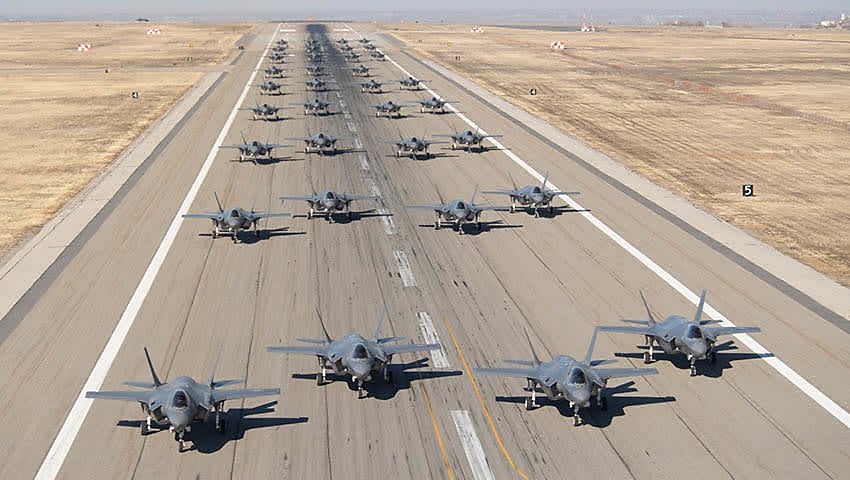Since the introduction of combat aircraft in the First World War, air power has served as the unrivaled king of the battlefield. Technology has transformed fighter and strike capabilities, while reinforcing the interoperability and power projection capabilities of modular, specialised forces, providing Australia with a powerful tool for enacting a power projection doctrine.
Throughout history, military operations have favoured those who occupy the high ground. Command of the skies empowers both offensive and defensive operations, while also providing powerful deterrence options as part of the broader implementation of power projection and national security doctrines.
Air dominance reflects the pinnacle of the high ground, where both a qualitative and quantitative edge in doctrine, equipment and personnel support the unrivalled conduct of offensive or defensive air combat operations. Air dominance proved influential as a tactical and strategic operating concept, with the use of tactical fighters providing air dominance, close air support and escort essential to the Allied triumph in the Second World War.
Long-range strike, typically conducted by strategic bombers and strike fighters supported by air-to-air refueling and airborne early warning and command aircraft, serves as a complementary doctrine to air dominance, with each serving a unique, yet symbiotic role in the survivability and effectiveness of tactical units and the broader strategic deterrence.
As technology has evolved, both air dominance and long-range strike platforms and doctrines have adapted to maximise the effectiveness of the symbiotic concepts within the broader confines of a nation's power projection doctrines.
The advent of the fifth-generation-era, whereby both tactical aircraft, namely fighters like the Lockheed Martin F-22 Raptor, F-35 Joint Strike Fighter family, Russian Su-57 and Chinese J-20 and FC-31, and strategic bombers like the Northrop Grumman B-2 Spirit and next-generation B-21 Raider, incorporate a range of technologies including advanced sensor suites, low observable, high performance airframes and coatings to successfully conduct their operations with impunity, even in heavily defended, integrated air defence networks.
Australia's unique operating environment, combined with alliance arrangements and geographic isolation present a series of equal challenge and opportunity for introducing a highly capable, modular and adaptable power projection focused fifth-generation air force.
Tactical fighter wings and success against IS
Australia's contribution the air combat campaign against the Islamic State in Syria and part of Iraq, using capabilities including the E-7A Wedgetail Airborne Early Warning and Control (AEW&C), KC-30A air-to-air refuelling tankers, classic F/A-18 Hornets and the Royal Australian Air Force's new F/A-18F Super Hornets and E/A-18G Growlers, proved to be a highly successful model for international air forces to draw upon for deployable, modular force structure packages.
These tactical fighter wings leveraged technology as a force multiplier, while combining traditional kinetic weapons and strike doctrines to eventually rout the forces of IS in the Middle East.
For the RAAF, the introduction of the F-35 has widely been recognised as a major step-change in the nation's air combat capabilities as a result of the force multiplying capacity of key fifth-generation technologies. Australia's early involvement in the F-35 program has enabled the nation to develop next-generation doctrine and operating plans in concert with partners like the US Air Force, with a focus on developing rapidly deployable, niche force structure packages.
The air transportable nature of the F-35's support infrastructure, including the Varley-designed deployable cabins and ALIS logistics system, combined with recent demonstrations of the expeditionary capability of the F-35 serve as a model for developing an air combat force capable of both continental defence and rapid response, power projection deployability.
An example of such a tactical wing could incorporate a wing of four-to-six F-35As and four-to-six EA-18G Growler electronic attack aircraft supported by a KC-30A air-to-air refueling tanker, an E-7A Wedgetail AEWC aircraft and a C-17 Globemaster to provide air mobility for supporting aircrew and material resources.
Long-range strike gap and the rise of the ‘loyal wingman’
Australia's retirement of the F-111 platform, combined with the the limited availability of the Navy's Collins class submarines, left the nation at a strategic and tactical disadvantage, limiting the nation's ability to successfully intercept and prosecute major strategic strikes against air, land and sea targets that threatened the nation or its interests in the 'sea/air gap', as defined in the 1986 Dibb review.
While the acquisition of the Super Hornets in the mid-to-late 2000s served as a partial stop-gap for that lost capability, the nation has not successfully replaced the capability gap left by the F-111.
The advent of increasingly complex and capable unmanned strike platforms like the Reaper series of unmanned combat vehicles and the persistent long-range intelligence, surveillance and reconnaissance capabilities of the MQ-4C Triton and RQ-4 Global Hawk all provide highly successful platforms and technology demonstrators.
Additionally, the recent announcement of the joint Defence Science and Technology and Boeing development of the 'loyal wingman' concept provides avenues for Australia to partner with defence industry primes and allies to develop a long-range, unmanned, low observable strike platform with a payload capacity similar to or indeed greater to the approximately 15-tonne payload of the retired F-111.
Such a capability would also enjoy extensive export opportunities with key allies like the US and UK who could operate the platform as a cost-effective replacement for larger bombers like the ageing B-52H Stratofortress, B-1 Lancer and B-2 Spirit, and supplement for the in-development B-21 Raider long-range strategic bomber.
These force structure concepts serve not only as powerful symbols of Australia's sovereignty, evolving responsibilities and role in supporting and enhancing the security and prosperity of Indo-Pacific Asia, they also serve as powerful 'hard power' examples of Australian diplomacy, furthering the nation's national interests and security agenda through a robust, air dominance and long-range strike focused air force.
Get involved with the discussion and let us know your thoughts on the future of Australia's air combat capabilities and the role power projection doctrines could play in future acquisition and force structure conversations in the comments section below, or get in touch at



